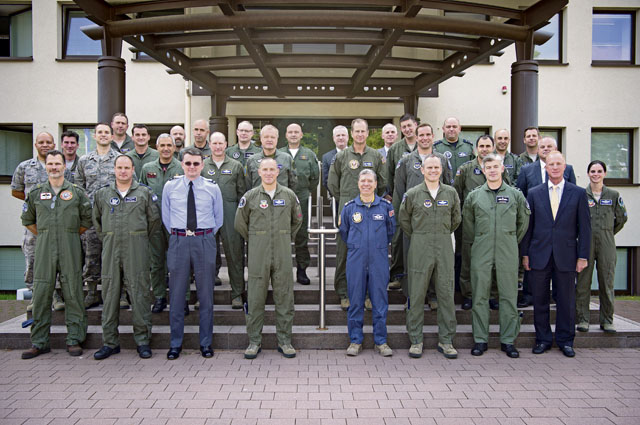
In the years since the release of the U.S. military’s newest fighter aircraft, the F-35 Lightning II has provided pilots unprecedented levels of survivability, lethality, and situational awareness, allowing warfighters to engage and win in hostile environments. A group of general officers representing the U.S. and each of the seven European and Mediterranean nations which will operate the F-35 met on Ramstein Air Base, Sept. 6, to discuss the aircraft’s implementation in Europe.
Gen. Tod D. Wolters, U.S. Air Forces in Europe — Air Forces Africa commander and Allied Air Command commander, represented the U.S. at the user’s group meeting.
“These aircraft bring revolutionary capability gains, due in large part to the F-35’s ability to seamlessly integrate with forces and assets in all domains: air, land, sea, space, special operations forces, and cyber,” Wolters said. “This multi-domain interoperability is a force multiplier that bolsters our defenses and allows us to project combat power in ways that were unimaginable a few decades ago.”
The U.S. uses the F-35 to stay on top of evolving threats and to modernize an aging fleet. The modernized, fifth-generation capabilities the F-35 brings to the fight include advanced stealth, improved electronic attack and electronic protection, and special sensors for enhanced situational awareness. These capabilities combined with traditional fighter characteristics of speed, maneuverability, and precision weapons enable victory in high-threat environments.
Lee Flint, USAFE 5th Generation Integration Division deputy chief, explained the difference between 4th generation and 5th generation fighters.
“In a nutshell, it’s blending unparalleled situational awareness with stealth,” Flint said. “[The F-35] provides aviators the capability to work in situations where they never could have worked before.”
Rather than replacing older fighters, Flint explained, the F-35 is designed to integrate with 4th generation aircraft and compliment the technology already in place.
Integrating the F-35s in Europe takes coordination. The general officers user’s group meets annually to strengthen ties and steer the aircraft’s future in Europe. Participating nations include Denmark, Israel, Italy, the Netherlands, Norway, Turkey, the United Kingdom, and the United States.
Flint noted several of the participating nations including, the United Kingdom, Norway, and Italy, already have operational aircraft in Europe. The U.S. can learn from the experiences unique to Europe those nations have had.
“We’re very excited to learn from their experiences and springboard from those to rapid operational capability,” Flint said.
“We need to keep those conversations going,” he continued. “That’s why opportunities like the European F-35 user’s group are so important to us.”
The group discussed how to ensure there is solid infrastructure in place for operational training when the aircraft arrive.
An example of the infrastructure challenges is making sure aviators have the airspace they need in order to practice and fly like they would in combat, Flint explained. He said personnel are learning to create air spaces in Europe to provide pilots with the room they need to hone their skills.
Another topic the user’s group discussed was the cost associated with the aircraft. The manufacturer, Lockheed Martin, reduced the cost of procuring and employing the aircraft, and intends to continue that trend.
“It’s important to remember that the F-35 is just getting started,” Flint said. “Even though more than 300 airplanes have been delivered worldwide, we’re just going into full-rate production very soon, and that’s where you’re really going to see dramatic improvements of purchase and maintenance costs. We’re learning every day.”
Flint said the Air Force has already experienced many operational and maintenance innovations that have reduced costs.
“It’s really young Airmen who are making the difference,” Flint said. “It’s people who are touching the airplanes every day. These young Airmen are innovators, and they’re creative. They’re working with the contractors to do things smarter, faster, better, and cheaper.”
Flint said that while some countries will not be operating the F-35s, they are still using their own capabilities to ensure the aircraft are successful in Europe.
“By blending those capabilities together, we’re creating opportunities to defend ourselves and to protect our way of life, and that’s what this is about,” Flint said. “It’s not about excluding people who don’t have airplanes. It’s about cooperation and integration.”
The user’s group is scheduled to reconvene later in the year to assess progress and determine the next steps for the F-35’s future in Europe.


